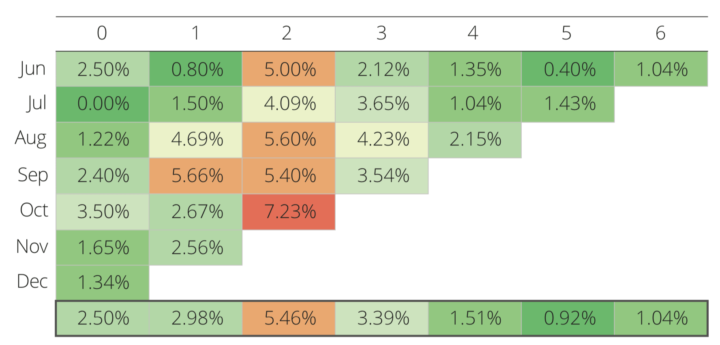Historically, mobile app monetization has largely been about scaling and optimizing ad revenue from in-app purchases (IAP). Metrics like ARPU and retention are a critical part of this process — scaling to millions of users means that the tiniest optimizations can make the difference between profit and loss.
Today, publishers have a lot more choice when it comes to picking a monetization strategy. Apple’s expanded support for subscriptions on iOS gives advanced control over pricing tiers and managing subscribers.
Many of the same app monetization metrics exist for subscriptions, but the way they’re measured differs considerably. This post takes a look at some of those differences.
ARPU, ARPPU, ARPDAU
IAP model:
There are a number of ways to look at the average revenue earned from users through in-app purchases.
Average revenue per user (ARPU) gives a basic view of user revenue across the entire user base. This is a widely accepted common measurement but can be skewed by outliers or non-paying users.
Average revenue per paying user (ARPPU) is useful in a freemium context, where paid users and free users are commonly segmented separately. Including non-paying users in revenue calculations can be misleading.
Average revenue per daily active user (ARPDAU) is an industry standard metric that averages revenue across the number of unique users who are active in a particular day.
Subscription model:
In the world of paid subscriptions there’s much less variety in the method for measuring average revenue.
Average revenue per account (ARPA) is the most widely accepted metric for this, and is calculated as:
ARPA = monthly recurring revenue (MRR) / # of customers
Note that in a freemium context, ARPA would usually only include paying users.
Customer lifetime value (LTV)
Customer lifetime value (LTV) is one of the most critical metrics in the mobile app monetization business. It allows publishers to confidently spend on acquisition (customer acquisition cost/eCPI), with the knowledge that any upfront investment will be paid back over the customers’ lifetime (plus — ideally — a profit).
The good news for publishers moving to a subscription model is that customers generally have a much higher lifetime value than those acquired through paid ads.
For ad-monetized apps, a good ratio between cost per install (eCPI) and LTV has been suggested as somewhere around 1:23 (i.e., LTV is 23x higher than cost of acquisition).
In B2B SaaS, that same optimal ratio (commonly referred to as the CAC:LTV ratio) is usually 1:3. This is down to much higher retention — and therefore a higher LTV. For consumer subscription businesses it may not be quite so high, but is still likely to eclipse that of advertising.
IAP model:
LTV for mobile apps is difficult to calculate, and relies on a lot of data to reliably predict customer retention over time. A commonly used formula for this type of LTV is:
LTV = average value of a conversion x average # of conversions in timeframe x average customer lifetime
Notice that here we’re measuring from multiple “conversions” across the lifetime, which is typical of an IAP monetization model (relying on repeat IAPs).
Subscription model:
LTV under a subscription model is simpler to estimate — however you should note that LTV is always an estimation or projection of the future, rather than a measurement.
The generally accepted “simple” formula for LTV is defined as:
LTV = (ARPA x gross margin) / customer churn rate
Retention and churn rate
IAP model:
When considering revenue from ads, there’s a much greater focus on retention rather than churn. It’s much easier to define and measure when a user returns to the app (is retained) than when a user churns. Since there’s no active recurring subscription, churning in this context just means ceasing to launch the app.
Retention rate is the percentage of users who continue engaging with your app over time, and is usually measured on 1-day, 7-day and 30-day intervals:
30-day retention rate = # of monthly active users / # of monthly installs
Churn rate, as mentioned above, can be difficult to measure in a non-subscription context. You need to decide the length of inactivity from a user before they’re considered “churned”. This variable is down to the design of your app and how much engagement you expect from users.
Subscription model:
With subscriptions, users are required to actively cancel (with the exception of failed or non-payments). This means that churn rate is easier to measure and can be defined in a standardized way.
Customer churn rate is the rate at which customers cancel their subscription:
Customer churn rate = # of churned customers in period / # of customers at start of period
Cohort analysis
Cohort analyses are one of the best ways to get a long-term view of user retention, and exist both for subscriptions and ad-supported revenue models.
How to read a cohort analysis

Although the cohort analysis chart can seem overwhelming at first, there’s a straightforward process for interpreting the data:
Rows = cohorts
Each row represents a cohort of your users. A cohort is simply a group of people, defined by some specific criteria. In this case, it’s users who subscribed in the same calendar month. Therefore each row (labeled with a month) is the group of users who subscribed in that month.
Columns = months
Each column (labeled in increments by a whole number) represents a single month following the initial subscription. Month zero is the month in which they subscribed, month one is the following month, and so on.
The default cohort chart is focused on customer churn rate, so the value in each cell is equal to the customer churn rate for that cohort, during that specific month in the customer lifetime.
Reading from left to right for each cohort, you can see the trend in churn rate over time and quickly identify spikes that could be caused by a specific event (such as a pricing change or product downtime). More importantly, you can look vertically at other cohorts at the same point in their customer lifetime to identify trends. This can help you focus on fixing problematic periods for users, either through focused communication or changes to the product itself.
Here are some examples of discoveries you can make with cohort analysis:
- “Month four has a large spike in customer churn due to a gap in onboarding communication”
- “Customers who signed up with a discount code are more likely to churn after month six”
- “The new pricing model seems to have addressed the retention problem around month three”
Recurring revenue adds greater precision, predictability
Mobile app publishers operating at massive scale (usually in the gaming space) have been able to reliably model retention and revenue metrics to balance the economics of their business. For the remaining 99% of publishers, this is much harder to achieve.
For many who adopt it, subscription revenue brings a refreshing level of measurability when it comes to scaling revenue and optimizing for profit in the longer term.
